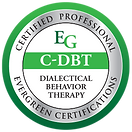
Lean in Therapy
Borderline Personality Disorder
To know for sure if you have BPD, you need to be assessed by a mental health professional. If it's something you're wondering about, here's a list of common behaviors and experiences for people who have BPD as well as the diagnostic criteria and treatment. Keep in mind that most of us will do any of these things during our lives, but it becomes concerning when these behaviors are seen in multiple settings (home, work, school), repeatedly, with little change.
1
Common Behaviors
-
History of being misdiagnosed with bipolar disorder
-
Intense fear of upsetting others
-
Poor memory
-
Going from "this person is awesome" to "I hate this person/this person annoys me" repeatedly
-
Getting upset when people change or cancel plans
-
Trying out different versions of themselves
-
Changing majors, careers, the types of clothes they wear frequently
-
Being interested in things based on who they're with
-
Getting obsessed with new hobbies that will, eventually, be forgotten
-
-
Asking "why am I like this?"
-
Difficulty moving forward after break ups
-
Multiple hospitalizations for mental health - often this starts in the teen years
-
Having multiple therapists over the years
-
Stopping therapy because they feel offended by something the therapist said or demanding the therapist prove their worth
-
Believing that the therapist will be the one to abandon them
-
-
Flipping between emotions quickly
-
Difficulty coming back from big emotions (getting stuck on a feeling)
-
Feeling like they are outside of their body, like life is a dream (dissociating)
-
Explosive anger over things that don't seem like a big deal to others
-
Feeling bored frequently especially if there isn't anything intense happening in life at the moment
2
Diagnostic Criteria
The Diagnostic and Statistical Manual of Mental Disorders (the giant book that has all of the recognized mental health diagnoses) says that someone with Borderline Personality Disorder (BPD) shows at least five of nine of these symptoms (American Psychiatric Association, 2013):
-
Frantic efforts to avoid real or imagined abandonment
-
A pattern of unstable and intense interpersonal relationships characterized by extremes between idealization and devaluation (also known as "splitting")
-
Identity disturbance: Markedly or persistently unstable self-image or sense of self
-
Impulsive behavior in at least two areas that are potentially self-damaging (e.g., spending, sex, substance abuse, reckless driving, binge eating)
-
Recurrent suicidal behavior, gestures, or threats, or self-harming behavior
-
Emotional instability in reaction to day-to-day events
-
Chronic feelings of emptiness
-
Inappropriate, intense anger or difficulty controlling anger (e.g., frequent displays of temper, constant anger, recurrent physical fights)
-
Transient, stress-related paranoid ideation or severe dissociative symptoms
American Psychiatric Association. (2013). Diagnostic and statistical manual of mental disorders (5th ed.). Washington, DC: Author
3
Treatment
BPD overlaps with ADHD and the treatments and agreements outlined here are to treat both sides of the disorder. The most widely accepted treatment for BPD is Dialectical Behavior Therapy (DBT) created by Dr. Marsha Linehan; more recent research has shown DBT is also effective for ADHD.
I combine multiple types of therapy because BPD is not straightforward and requires a lot of different tools to manage it. Here is what I use:
-
Cognitive Behavioral Therapy to question unhelpful, destructive thoughts and re-write deep, negative beliefs about the self
-
Dialectical Behavior Therapy to provide skills to use when someone is struggling such as finding distractions and skills to create a life worth living such as collecting positive experiences
-
Internal Family Systems to understand and appreciate how even painful self-talk can be trying to help us keep going - this is then paired with CBT to find less painful ways of talking to ourselves
-
Coaching for organization and daily life structure
Agreements for therapy:
-
Attend sessions as scheduled
-
Complete homework between sessions
-
Consider medication with a psychiatrist or psychiatric nurse practitioner for mood stabilization and ADHD symptoms (medications are not required for therapy, they're just something to consider)
-
Engage in physical activity e.g. sports, exercise classes, yoga, martial arts, taking walks


